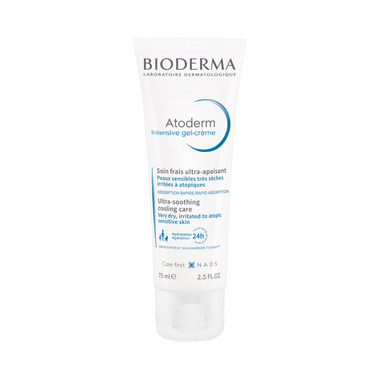Rs. 899
Available in other variants

Product Details
Bioderma Atoderm Intensive Gel Cream is the 1st treatment with a nourishing and ultra-fresh texture for very dry skin or skin prone to atopic eczema, which facilitates the daily application of the emollient.
It quickly and durably soothes itching sensations and reduces the urge to scratch thanks to the enoxolone derivative. The hydro-absorbent technology retains the surrounding water in order to optimise the hydration of the skin and reinforce its barrier function. It thus makes it possible to limit the sensations of itching and therefore irritation.
Thanks to vitamin PP, Atoderm Intensive Gel Cream replenishes lipids and strengthens the skin barrier durably.
The patented Skin Barrier Therapy™ complex limits the adhesion of certain bacteria (staphylococcus aureus) to the surface of the skin, which can be the cause of the aggravation of skin dryness.
Key Ingredients:
Key Benefits:
Directions for use:
Once or twice a day daily.
Safety information:
It quickly and durably soothes itching sensations and reduces the urge to scratch thanks to the enoxolone derivative. The hydro-absorbent technology retains the surrounding water in order to optimise the hydration of the skin and reinforce its barrier function. It thus makes it possible to limit the sensations of itching and therefore irritation.
Thanks to vitamin PP, Atoderm Intensive Gel Cream replenishes lipids and strengthens the skin barrier durably.
The patented Skin Barrier Therapy™ complex limits the adhesion of certain bacteria (staphylococcus aureus) to the surface of the skin, which can be the cause of the aggravation of skin dryness.
Key Ingredients:
- Glycerin
- Niacinamide
- Sodium polyacrylate
- Dipotassium glycyrrhizate
- Hydrogenated polydecene
- Pentylene glycol
- Caprylyl glycol
- Mannitol
- Polysorbate 20
- Xylitol
- Rhamnosus
- Sodium citrate
Key Benefits:
- Bioderma Atoderm Intensive Gel Cream restores, replenishes and soothes the skin
- It increases the feeling of comfort and makes the skin more resistant in a lasting way
- Nourishing and ultra-fresh texture of the cream has very good tolerance
- Light and non-sticky texture supports its rapid absorption into the skin
- Accompanies the care of very dry skin or skin prone to atopic eczema according to the new European recommendations in dermatology
Directions for use:
Once or twice a day daily.
Safety information:
- Keep out of the reach of children
- Store in a cool and dry place
- Read the label carefully before use
- Avoid contact with the eyes












